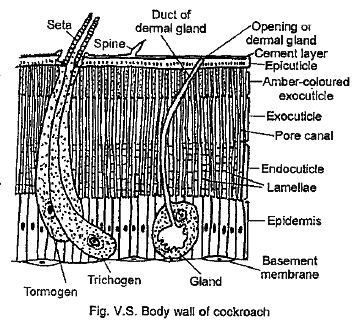Write a note on the locomotion in cockroach.
Text Solution
Locomotion. When the cockroach is at rest the coxae oflegs lie backward against the body and first pair of legs are directed forward and hind legs are stretched out posteriorly and middle legs take whatever position is convenient. During locomotion on land, six legs are used as two tripods. The first and third leg of one side and middle leg of other side fonn a triangle on which insect rests while other three are advanced and placed on the substratum. This process is repeated by other three legs and insect moves in a zig-zag manner.. The locomotion is co-ordinated by the ventral nervecord.
Body Wall
It consists of mainly three layers : Cuticle, epidennis and basement membrane.
I. Cuticle. It is the outennost layer. It is further made up of three layers :
(a) epicuticle of waxy nature
(b) exocuticle of tough pigmented chitin
(c) endocuticle of soft laminated chitin
The epicuticle has an outer layer of wax like lipid and an inner layer of hard protein.

2. Epidermis. There is a single layered epidennis which is made up of columnar cells. Cuticle is also secreted by epidennis. Epidennis has following type of cells :
(i) Columnar cells. Main cells of epidennis.
(ii) Gland cells. Modified columnar cells. Gland cells are also known as dennal glands. Gland cells secrete chitinase and protease which help in dissolving old cuticle.
(iii) Oenocytes. Large, irregular shaped cells. Oenocytes secrete wax over cuticle and some lipoprotein of epicuticle.
(iv) Trichogen cells. Secrete setae, bristles and hair.
(v) Tromogen cells. Form socket around trichogen cells. Also secrete articular membrane.
Sensilla is a sensory unit present on body wall. A sensilla consists of trichogen cells, tromogen cell, setae or bristle or hair connected with this trichogen cell and nerve cell.
3. Basement Membrane. It consists of flattened cells placed in a homogeneous intercellular substance.
The body wall at places bears hair-like movable setae and stout, immovable spines.
Functions. The body wall has many functions.
1. It maintains the body form.
2. It protects the delicate internal organs from injury, harmful chemicals and entry of microorganisms.
3. Its waxy coating checks both absorption and loss of water besides making the body unwettable.
4. It provides hard surface for the attachment of body muscles.
5. It helps in respiration by allowing diffusion of carbon dioxide.
6. The outgrowths of the cuticle form sensory, defensive, feeding, copulatory and locomotory organs.
|
Similar Questions
Knowledge Check
Which character is / are associated with locomotion ?
(A) All locomotion are movements
(B ) All movements are not locomotions
(C ) Methods of locomotion vary with animals habitats
(D ) Locomotion is also for escape from predatorsAA and BBB,C and DCA,B and CDA,B,C and D
Write a note on plasmolysis,
View SolutionWrite a short note on directing.
View SolutionGive an account of locomotion in earthworm or cockroach.
View SolutionWrite a note on desert adaptations.
View SolutionWrite the zoological name of cockroach.
View SolutionWrite short note on protochordates.
View Solution(a) Write a note on Hell-Volhard-Zelinsky (HVZ) reaction.
(b) Write a short note on Koch reaction.
(c) Write a short note on Arndt-Eistert reaction
View Solution
